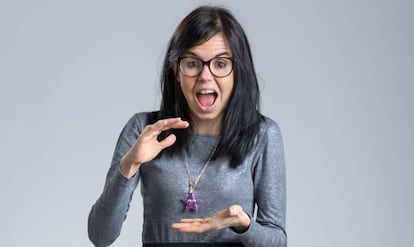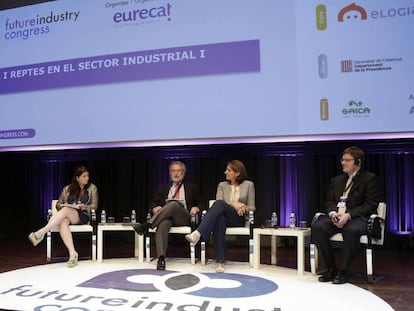Raising the profile of female scientists, one Wikipedia article at a time
British physicist Jessica Wade is on a mission to showcase achievers who have been ignored by their peers by adding their information to the online encyclopedia

Just like most female physics researchers in Britain, Jessica Wade went to a girls’ school. She now holds a PhD in physics from Imperial College London, where she is studying plastic electronics as a research associate. “When I began my PhD I was the only girl in the research group. My best girlfriend graduated, and suddenly it became very hard for me to be in this university that I loved so much without a support network. That was when I realized that this must happen to all women in all departments when they don’t have that best friend,” she explains.
Besides her research, Wade does considerable outreach work to ensure that more girls will choose careers in science. A founder and coordinator of several associations, she works with the British Institute of Physics (IOP) and delivers talks in schools. But Wade has another, more unusual method to increase the representation of women in science: she writes Wikipedia articles about women scientists. One every day.
Creating Wikipedia articles about women scientists is “a global movement,” says Wade
Creating Wikipedia articles about women scientists is “a global movement,” says Wade, who found inspiration in a US medical student named Emily Temple-Wood who began contributing to Wikipedia at age 12. After receiving scores of sexist comments through email and social media, Temple-Wood decided to “channel her anger” in a constructive way by writing up a Wikipedia article about a woman in science for every abusive message that she got. In a short space of time, this young woman was leading a group of contributors who managed to raise the quality of biographical articles on women scientists above average; this is known as the “Keilana Effect,” after the name she uses on the site.
Wade has followed her lead by writing up seven new articles a week. She has already written hundreds, and spends hours doing research at the archives of science institutions, attending conferences, and using Twitter to locate women scientists, either dead or alive, who have been ignored by society.
For every 100 Wikipedia biographies in English, only 17 are about women, she notes. “But that 17% is not just for scientists. In science, where women are already underrepresented, it’s much worse.
For every 100 Wikipedia biographies in English, only 17 are about women, she notes
“It’s not just a sad and discriminatory reality, it’s also that the few existing articles on women scientists usually do no more than list the prizes they have won, mention the fact that they are women, or else talk about their husbands,” says Wade angrily. “And if you go to the website of a scientific discipline where you know that a woman has made a significant contribution, it is very rare for her, or for her contribution, to be mentioned at all. It makes me really mad.”
Notability
The most important part about creating a new biography is demonstrating why this person is notable and “deserves” a Wikipedia article. And this is typically very difficult. “I can’t write an article about my friend just for the heck of it. In science, you normally need to have a given number of published works,” says Wade. “My own page was written by an engineer from Imperial College, but I’m really embarrassed about it, I don’t have enough published work to be notable!”
In the case of science writers and communicators, the notability criteria are more ambiguous. “Sometimes you write an article about a woman who is contributing more to the conversation about science than to direct research, and people quickly start pointing out that there is no notability or that she has made no contributions. It’s horrible to read that. It would be horrible to read that about yourself,” she says.
It is precisely because of such comments that Wade tries to wait for her texts to be reviewed by experienced editors before sharing them. “But we need greater diversity among the editors; there is a bias there as well because most of them are men.” And there is an added problem, she says: “I have realized in an anecdotal way, I still don’t have statistics on it, but it seems like those comments appear faster when the woman is not white. I really find that terrible.”
In the meantime, there is an international movement to improve diversity in Wikipedia’s other languages. “In Spanish I believe that 18% of biographies are about women. It’s a bit better, but of course it’s a much smaller Wikipedia [than the English-language one]”. The advantage of this is that there are so few editors in other languages that it’s very easy to get started and feel welcomed by the new emerging community. For anyone considering it, Wade has a piece of advice: “A very easy way to start editing Wikipedia in Spanish is by translating articles from the English-language version. That would be great.”
Wikithons
Anyone can edit Wikipedia. There is no need to register or create a username. But because a lot of people need a little push to get going, Wade regularly organizes wikithons where groups of people inside a room make a collective effort for an hour or two. "All you need is a computer, someone who understands Wikipedia and a group of people who are motivated to do good," says the British physicist.
These wikithons can take place at conferences, summer camps or university groups, but they work particularly well at schools. "Teachers love them because it requires using many abilities, such as consulting impartial sources and writing up a bibliography, which coincides with the class material that they want to teach anyway," says Wade. "And they have an incredible effect on young people. We're always told that "we need more women in science," but we're tired of hearing that. If students get to know these women by working together, they really start to appreciate the incredible discoveries they have made."
English version by Susana Urra.
Tu suscripción se está usando en otro dispositivo
¿Quieres añadir otro usuario a tu suscripción?
Si continúas leyendo en este dispositivo, no se podrá leer en el otro.
FlechaTu suscripción se está usando en otro dispositivo y solo puedes acceder a EL PAÍS desde un dispositivo a la vez.
Si quieres compartir tu cuenta, cambia tu suscripción a la modalidad Premium, así podrás añadir otro usuario. Cada uno accederá con su propia cuenta de email, lo que os permitirá personalizar vuestra experiencia en EL PAÍS.
¿Tienes una suscripción de empresa? Accede aquí para contratar más cuentas.
En el caso de no saber quién está usando tu cuenta, te recomendamos cambiar tu contraseña aquí.
Si decides continuar compartiendo tu cuenta, este mensaje se mostrará en tu dispositivo y en el de la otra persona que está usando tu cuenta de forma indefinida, afectando a tu experiencia de lectura. Puedes consultar aquí los términos y condiciones de la suscripción digital.










































